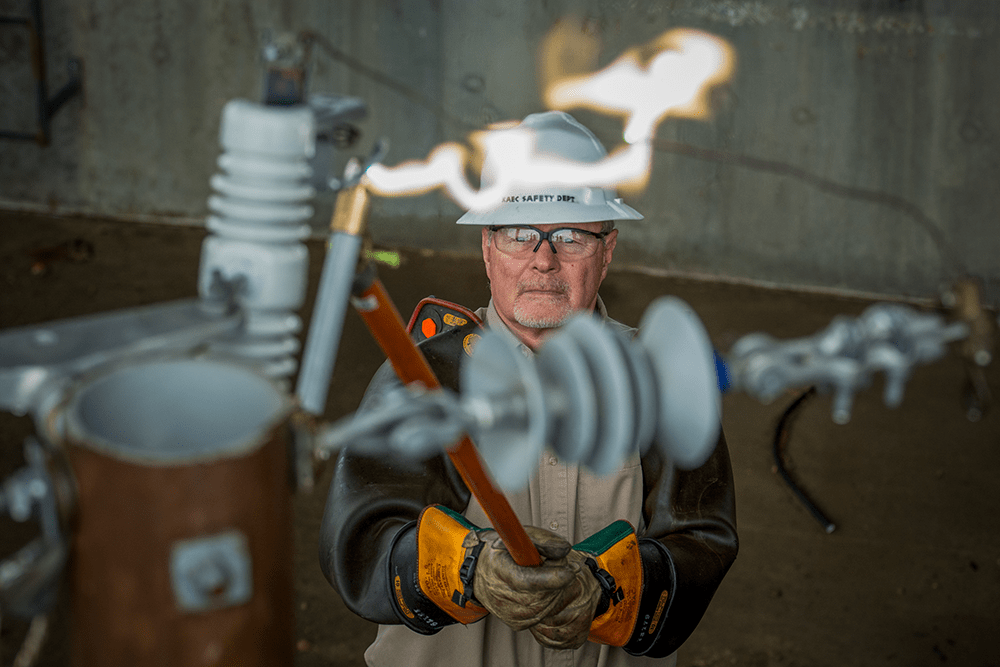Retrain your brain to be careful around electricity
By Paul Wesslund
FAMOUS LAST WORDS: “IT’LL BE ALL RIGHT.” OR, “I KNOW WHAT I’M DOING.” You know that something bad can follow either of those ominous beginnings. The bad things that could happen are at the top of the mind of electric co-op workers all across the state.
They know electricity can be dangerous enough to injure or kill. And you know that, too. But accidents still happen.
The goal of this story is to make fewer of those accidents happen, and maybe even save your life or the life of someone in your family.
One way to start telling this story is to listen to Clarence Greene. As the director of Safety and Loss Prevention for the Kentucky Association of Electric Cooperatives, he and his team—safety instructors Kendall Bush, Robert Thornton, and Charlie Lewis—spend every day thinking about how to keep people safe around electricity. Greene has heard comments like the ones above, and he’s familiar with the sometimes-fatal result when people take safety shortcuts.
“People feel like they want to accomplish things. They don’t want to ask for help,” says Greene. “We all want to save time and money. We’ve got the attitude, ‘It can’t happen to me.’”
“False sense of security”
So why does our brain think accidents only happen to other people?
“There’s a psychological term for that,” says Dr. Sarah Shelton, licensed clinical psychologist and president-elect of the Kentucky Psychological Association. “It’s called ‘optimism bias.’ We see ourselves as special. Statistics don’t apply to us.”
Dr. Shelton, who practices in several cities across Kentucky, says our brains get lulled into taking electric safety for granted because we’re around it all the time.
“We handle plugs every day with no adverse effect,” she says. “It gives us a false sense of security.”
Dr. Shelton also blames the fast-paced world of smartphones and constant, multiple demands for our attention.
“We live in an overstimulated society with sensory overload,” she says. “Our brains are doing more than they can handle almost all the time.”
Part of that information barrage puts us in danger by trying to convince us we can do anything.
“YouTube videos take on the image of credibility and convince us we can do anything from baking cookies to changing oil to performing a triple coronary bypass,” says Dr. Shelton, maybe only half-kidding about the bypass surgery. “This can give us a false confidence in our own abilities. Saving a few dollars can be very alluring and being good stewards of our possessions can be a noble thing, but it can work against you in risks and safety.”
The next safety revolution
Steve Casner would agree we’re too distracted to be safe. He’s a research psychologist who just published Careful: A User’s Guide to Our Injury-Prone Minds. In that book he cites a 100-year trend of declining unintentional injury deaths in the United States. At least it was declining until 1992, when the rate of fatal injuries leveled off and then started to increase, setting us back to where we were 30 years ago.
Like Dr. Shelton, Casner blames the do-it-yourself movement and innovations that give us complicated gadgets to fool with while we drive faster cars. Casner says we’ve made ourselves safer with changes like seat belts and child-proof medicine caps, but he adds that further improvement calls for a new approach.
“We have wrung all the big gains we’re going to get from putting rubber corners on stuff,” Casner writes. “The next safety revolution is going to have to happen in our own minds.”
And we can change our own minds, says Dr. Shelton: “You can retrain your brain so you have good habits instead of bad habits.”
To do that, she says, take a lesson from airline pilots, who stay safe by following a rigid checklist.
A good personal checklist, Dr. Shelton recommends, uses the initials SEA—Stop, Evaluate, Act.
“It’s important to stop, slow down, and be aware of our surroundings,” she says, “and then to act—avoid the temptation to reach for the phone when you’re driving or on top of a ladder. Learn to ask yourself, ‘Is this worth my life?’”
KAEC safety director Clarence Greene, whose quotes started this story, provides a fitting finish with his top three important safety tips:
“No. 1, stay away from power lines. No. 2, stay away from power lines. No. 3, stay away from power lines.”

